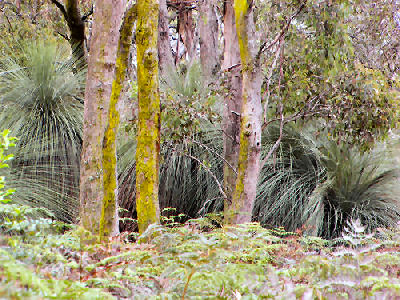Comments on recent fire-management in bush-fire areas
 1) Much of the fire burnt most intensively through dry forest with euc species such as Euc radiata and Euc dives. These trees have no market value for the logging industry and usually no logging takes place in them. On the Modis fire satellite image, the fire appears to have burnt these forests most intensively, whereas the wetter forests are patchy. The towns of Marysville, Kinglake and St Andrews are surrounded by these drier forest types, so it is not surprising that we see the highest levels of devastation in these areas.
1) Much of the fire burnt most intensively through dry forest with euc species such as Euc radiata and Euc dives. These trees have no market value for the logging industry and usually no logging takes place in them. On the Modis fire satellite image, the fire appears to have burnt these forests most intensively, whereas the wetter forests are patchy. The towns of Marysville, Kinglake and St Andrews are surrounded by these drier forest types, so it is not surprising that we see the highest levels of devastation in these areas.
2) These fires burnt very aggressively in plantations. The Churchill fire mostly burnt through plantation areas managed by Hancock Victorian Plantations and its subsidiaries. These plantations are obviously intensively managed with wood production as their primary purpose, yet these burned very intensively.
3) Around Whittlesea, Wallan and East Kilmore, the much of these fires burnt through long grass on farmland. The argument of forest protection around these areas is irrelevant, given that these areas are cleared farmlands and had very little forest areas upwind on Saturday.
4) The fire on Mt Riddle is an interesting case. This fire was ignited by a lightning strike and has burnt the northern slope. At the beginning of last year, the DSE/Parks Victoria lit a large control burn on this slope, of which it even scorched the crowns of the eucs. This control burn has not prevented the ignition and spread of this fire into Healesville and surrounding forest.
5) Many of these fires have started on either private land or non-forest areas (ie the fire that burned over Mount Disappointment). The only fire at this stage to have started in National Park was the Mt Riddle Fire. The Mt Disappointment/Whittlesea fire raced over in a SE direction into the protected Wallaby Creek catchment.
6) Large fire breaks had been cut through Mt Disappointment bounding the Wallaby Creek water catchment. It could be argued that this is 'active management' by the logging industry, given that the breaks were cut by the contractors. Yet they were useless in preventing the fire from spreading from the state forest into the protected Wallaby Creek catchment.
7) It is suspected that the fires west of Mt Disappointment and Yarra Glen, along with Churchill, were deliberately lit. This is a case of managing 'people' rather than forests. Authorities need to clamp down on arsonists and when convicted, they are put on a police register for life, similar to sex offenders. When high fire danger days are predicted, these 'registered people' need to be directly monitored by the police.
8) These fires are being intensified by a rapidly changing climate. Scientific models developed by the CSIRO have predicted that high fire danger days are going to increase dramatically with increased greenhouse gas levels in the atmosphere. In addition, it should be noted that scientific studies around the world indicate that highly disturbed ecosystems will be more vulnerable to the climate crisis than less disturbed ones.
Source: Remarks from a correspondent

Recent comments